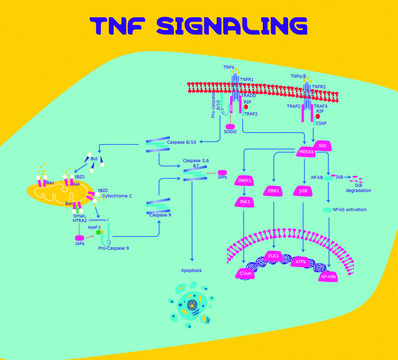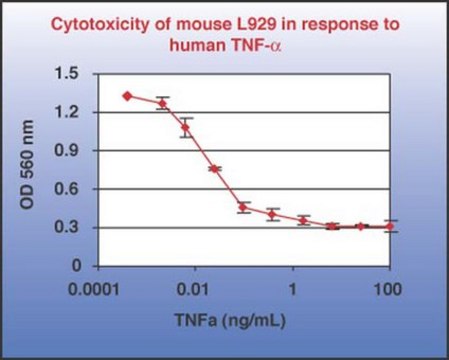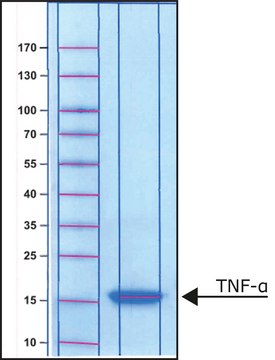11088939001
Roche
Tumor Necrosis Factor-α, human (hTNF-α)
recombinant (yeast)
Recommended Products
biological source
human
Quality Level
recombinant
expressed in yeast
Assay
≥95% (SDS-PAGE)
form
solution
potency
≤0.01 ng/mL EC50
specific activity
>1*10^8 U/mg (>1 x 10⊥8 U/mg, <0.01 ng/ml (hTNF-a, NIBSC, interim standard, 87/650), at least the same specific activity (EC50) compared to the indicated standard is guaranteed.)
mol wt
17,000 Da
packaging
pkg of 1,000,000 U (10 μg, 1ml)
manufacturer/tradename
Roche
storage condition
avoid repeated freeze/thaw cycles
impurities
<0.1 EU/μgtested (LAL test)
UniProt accession no.
storage temp.
−20°C
Gene Information
human ... TNF(7124)
Related Categories
General description
Recombinant, Tumor Necrosis Factor-α, human (hTNF-α), is produced in Pichia pastoris and purified by standard chromatographic techniques.
Primary structure: One polypeptide chain (157 amino acids), identical to natural hTNF-a.
Specificity
Application
- Shows cytolytic and/or cytostatic activity on a variety of transformed cell lines.
- Has activating and growth stimulating activities on a variety of normal cells.
- Has antiviral activity on many cell types in vitro.
- Can cause tumor necrosis of certain tumors in vivo.
Biochem/physiol Actions
Quality
Endotoxin level: <0.1 EU/μg (LAL-test), <10 EU/ml (LAL-test)
Sequence
Unit Definition
Physical form
Preparation Note
For complete cell lysis of sensitive cell lines about 1 ng/ml is recommended.
Working solution: Dilute the concentrated hTNF-α solution (10 μg/ml) with PBS or culture medium containing BSA (or HSA), 1 mg/ml (0.1%) or serum 1 to 10%.
Storage conditions (working solution): -15 to -25 °C
It is recommended to store the solution in aliquots at -15 to -25 °C.
Note: Avoid repeated freezing and thawing.
Other Notes
WGK
nwg
Flash Point(F)
does not flash
Flash Point(C)
does not flash
Regulatory Information
Certificates of Analysis (COA)
Search for Certificates of Analysis (COA) by entering the products Lot/Batch Number. Lot and Batch Numbers can be found on a product’s label following the words ‘Lot’ or ‘Batch’.
Already Own This Product?
Find documentation for the products that you have recently purchased in the Document Library.
Our team of scientists has experience in all areas of research including Life Science, Material Science, Chemical Synthesis, Chromatography, Analytical and many others.
Contact Technical Service



